(v12.08.14)
Art, Architecture and Design
This section spotlights a particular building or some other aspect of Columbus design. I welcome your comments, corrections and additions. Please share your experience and perceptions of these uniquely Columbus projects.
 Columbus Post Office
Columbus Post Office
- Built – 1970
- Architect – Kevin Roche and John Dinkeloo (Roche Dinkeloo & Associates: Hamden, Connecticut)
In the early seventies, downtown Columbus was starting to show the physical results of years of planning. City officials had begun to see the changing patterns of shoppers as new stores and branches of existing downtown stores were opening up in shopping centers away from the downtown core area. Although the downtown area was rich with many sturdy and beautiful 19th century buildings, many were deteriorated and crumbling. The downtown Irwin-Union bank built in 1954 showed how a modern building could be successfully integrated into the existing footprint of the historical downtown area. Numerous studies led to a master plan for redevelopment of the downtown area which preserved and revitalized many existing structures and led to many new buildings.
One of the first buildings to go up during the 70’s phase of downtown redevelopment was the Columbus Post Office designed by Kevin Roche along with his partner John Dinkeloo. Roche was no stranger to Columbus, having taken over the building of North Christian Church after the untimely death of Eero Saarinen. Roche, who had been a close associate of Saarinen took over a dozen ongoing projects of Saarinen’s and then started his own firm partnering with John Dinkeloo who also had been part of the Saarinen office. Roche had also worked closely with Eero Saarinen on the Miller House in Columbus.
Our Columbus Post Office is often cited as being the first Post Office to be designed by a major architect whose fees were privately funded. It is unlikely that the federal government had ever received such an offer before when the Cummins Foundation agreed to pay the architect design fees for the new building. The foundation established by Cummins and J. Irwin Miller in the 50’s was originally intended to fund the design of new schools but was later extended to other public buildings in the community.
What Roche designed was really an outer shell surrounding a predetermined government layout. The interior is very simple and functional to meet the needs of the postal service to both process mail for delivery as well as to provide an area for customer service. One of the reasons the city was anxious to move the Post Office from its former overcrowded site a few blocks away was to lure those postal customers into the new urban shopping mall which was being planned and was finished a couple of years later just adjacent to the building.
Roche constructed the building using Cor-Ten steel, salt-glazed tile and mirrored glass. Cor-Ten steel has a high tin content which oxidizes to form a protective maintenance free finish with a rich brown color. It had been used extensively by Saarinen and Roche on the John Deer HQ building in Moline, Illinois. Critics of this product however just call it rusty and that was in fact used as one of the reasons when recent plans called for the building to be demolished for yet another round of downtown redevelopment. Salt glazed tile is a material that was used for years to build farm silos. These tiles were glazed a reddish-brown color to match the weathered steel. Large mirrored-glass window walls and doors in the front provide interesting reflections on the outside but are transparent on the interior. High ceilings on the inside combined with the tall front windows provide a spacious feel to the narrow front customer lobby.
Massive square pillars in the front are covered with the same tiles as the outer walls to form a pedestrian arcade on the sidewalk along the Jackson Street side. The reflective front surface doubles the apparent depth of the arcade making a rather small building appear very governmental. The building was designed to suggest traditional form and character without losing its modernist individuality. The columns along the front were meant to be reminiscent of traditional federal buildings while also suggesting the open arcades once typical of small Midwestern towns. Roche later extended the idea and the lines of this pedestrian arcade along Jackson Street when he designed the Cummins Corporate Office Building. The corner of 5th and Jackson has often been called “Kevin Roche corner” as he designed the Post Office, the Cummins HQ and a rear addition to the Irwin-Union Bank. The covered walkway of the Post Office was later joined by the glass arcade designed by Roche at his addition to the Irwin-Union bank which joined Washington Street to Jackson and the covered walkway along the 4th Street side of the now demolished portion of the Commons Mall which took pedestrians back to Washington Street. This circular pedestrian network seemed well conceived but those pedestrians never seemed to stray that far from their automobiles. The small parking lot along the left side as well as the rear docks and staging areas are camouflaged by walls using the same tile material on the building exterior.
At the dedication ceremony on July 19th, 1970, the only female on the speakers platform was a Miss Taffy Adams who held the honor of “Miss Zip Code” for the national Postal Service. Also in attendance were Kevin Roche and John Dinkeloo, the national Postmaster General and several Congressmen. After the opening, the Columbus Post Office was only the second Post Office in the country to have a Congressional Office in the same building when our then US Representative opened his office there.
Unfortunately, the building has not held up well over the years whether from lack of proper maintenance or problems with materials. The tiles (which are no longer manufactured) have cracked or crumbled in some places or fallen, especially on the columns. They have used a “band-aid” approach to correcting the problems using putty and steel bands around the columns to prevent them from possibly falling on pedestrians. Other problems have been numerous leaks in the flat roof, rust stains on the windows caused by rain running off the Cor-Ten steel and a running battle with birds nesting in the canopy over the sidewalks. Since the Postal Service only leases the property they have not been willing to devote any large sum of money on major upgrades to the building. They have however done what is necessary to keep it up as a clean and safe environment for customers.
In the interior they have painted the dark tiles white to make a lighter environment and commissioned a large mural to be placed over the customer service area. In the tradition of the WPA murals painted during the depression, the Post Office now features a 25 foot, 5-panel painting called “Generations” by local artist Betty Boyle. It shows the progression of Columbus architecture from the early days of the area to the present. Appropriately, one of the panels shows the Post Office colonnade with pigeons lingering overhead.
Now sitting in the middle of another huge downtown redevelopment project, the Post Office appears to be endangered. The current master plan for downtown would like to see a mixed use housing/retail project on the spot. City officials have been using the maintenance issues to build a case against the building. They even managed to line up several prominent local architects to declare it as not architecturally important or worth saving. The actual owners of the land and building appear to be willing to sell and the Postal Service is willing to move as long as another building is built at no cost to them. Since the city now has nearly every penny of development money tied up in current projects and bond issues, it will for now take a private developer willing to cover most of these costs.
Hopefully people will take another look at this little building and consider it worth saving. I love the look and feel of the building and how it fits so well on the block with the Cummins HQ. Unfortunately there was little or no opposition when the Commons and Commons Mall were torn down so it is unlikely that much fuss will be made over this one as it has never been popular locally. It could easily be adapted to another type of use since the interior is largely an open area used for mail processing. I would love to at least see the front of the building and that amazing colonnade saved and restored.
 Front entrance along Jackson street (photo by Ricky Berkey)
Front entrance along Jackson street (photo by Ricky Berkey)
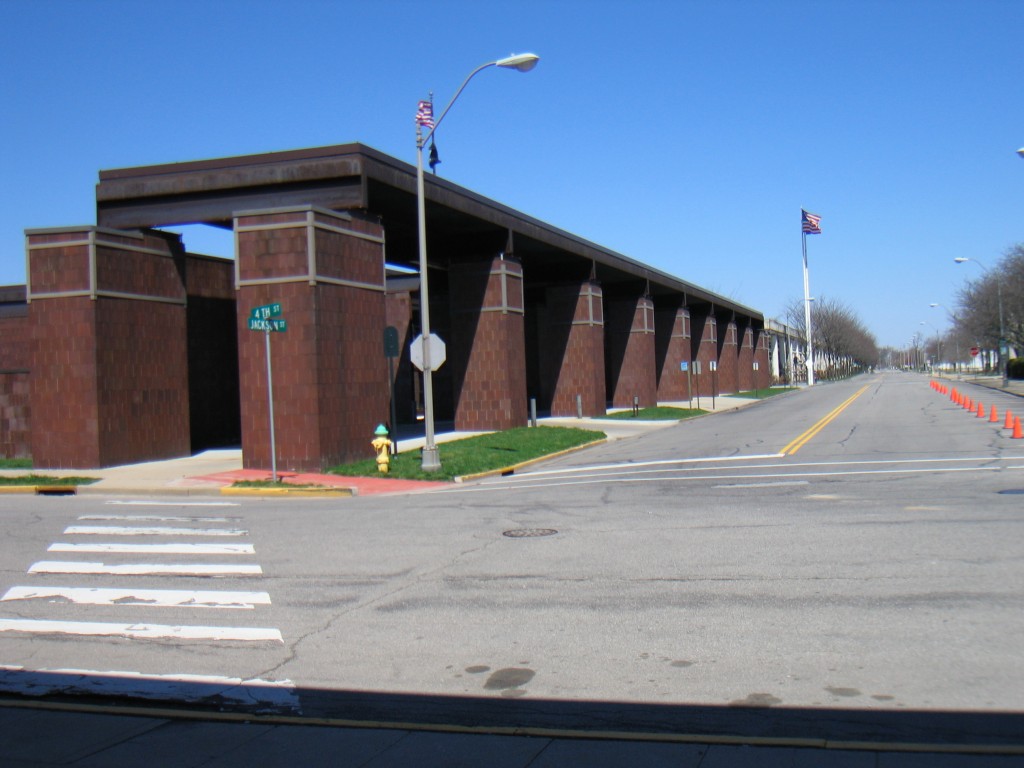 Front of building along Jackson Street (photo by Ricky Berkey)
Front of building along Jackson Street (photo by Ricky Berkey)
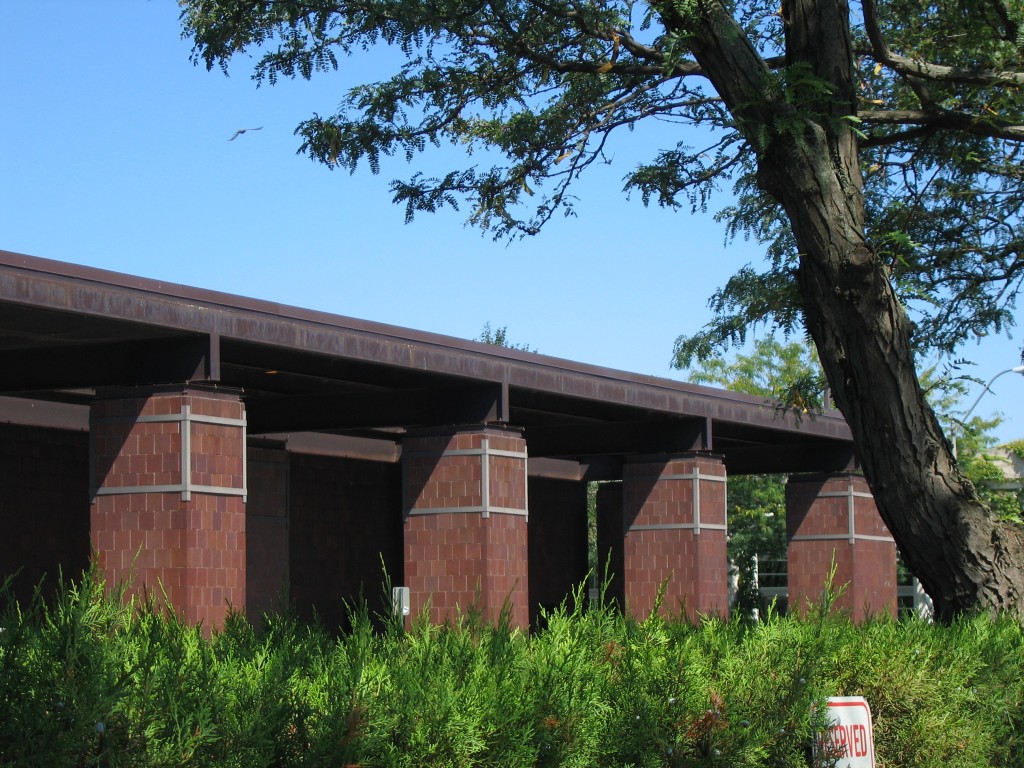 Front of building (photo by Ricky Berkey)
Front of building (photo by Ricky Berkey)
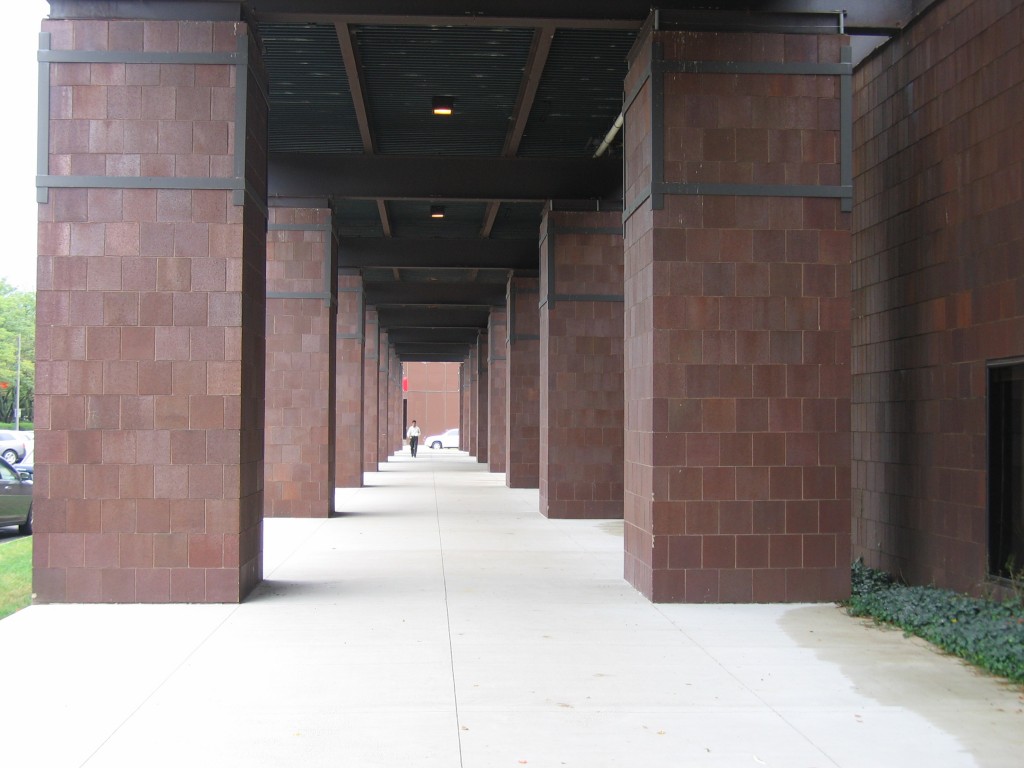 Down the sidewalk in front of the building (photo by Ricky Berkey)
Down the sidewalk in front of the building (photo by Ricky Berkey)
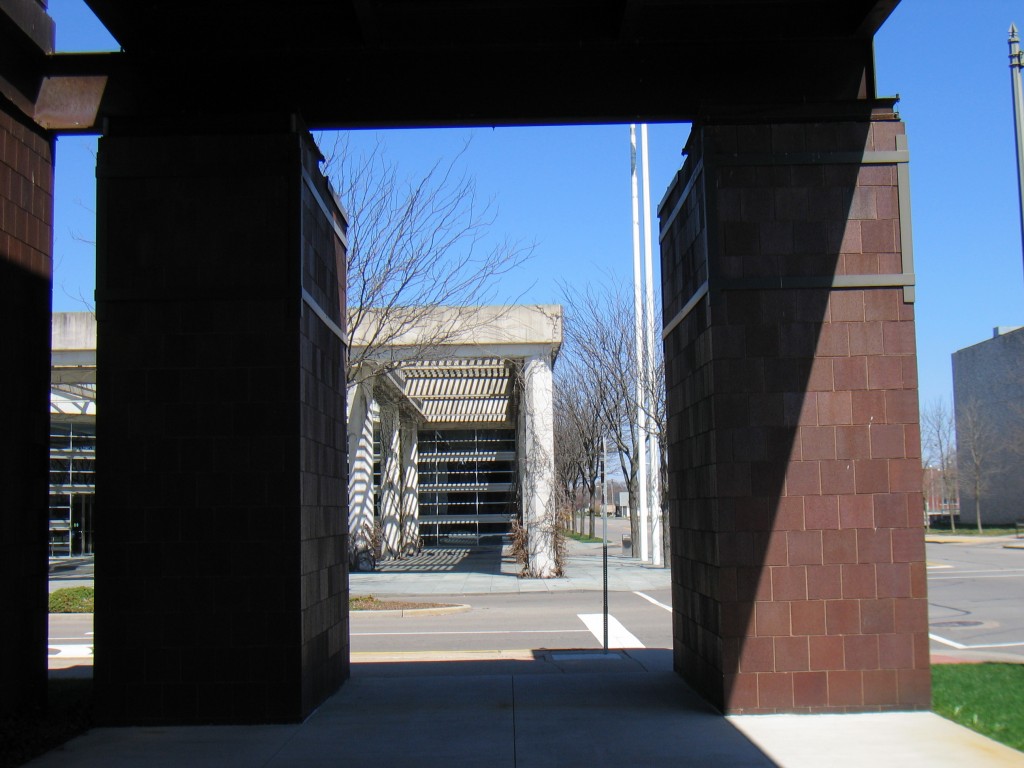 Between the front sidewalk columns showing the Cummins HQ building across the street, also designed by Kevin Roche (photo by Ricky Berkey)
Between the front sidewalk columns showing the Cummins HQ building across the street, also designed by Kevin Roche (photo by Ricky Berkey)
 Notice the now demolished portion of the Commons Mall in the distance (photo by Ricky Berkey)
Notice the now demolished portion of the Commons Mall in the distance (photo by Ricky Berkey)
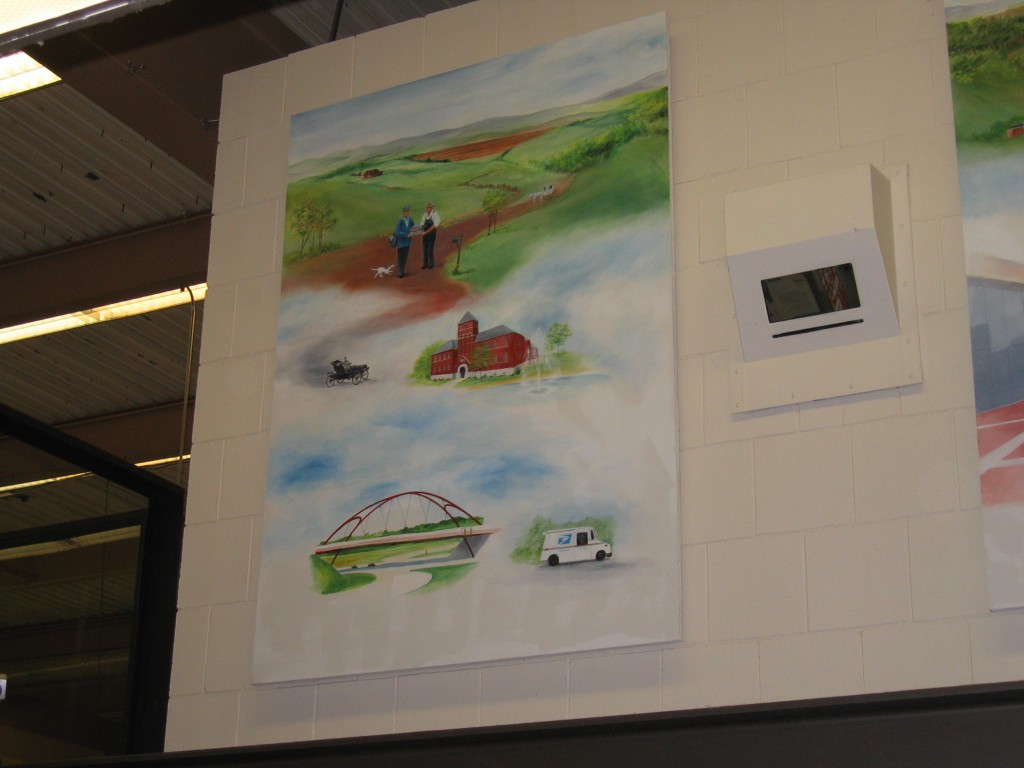 Panel 1 of the Betty Boyle mural (photo by Ricky Berkey)
Panel 1 of the Betty Boyle mural (photo by Ricky Berkey)
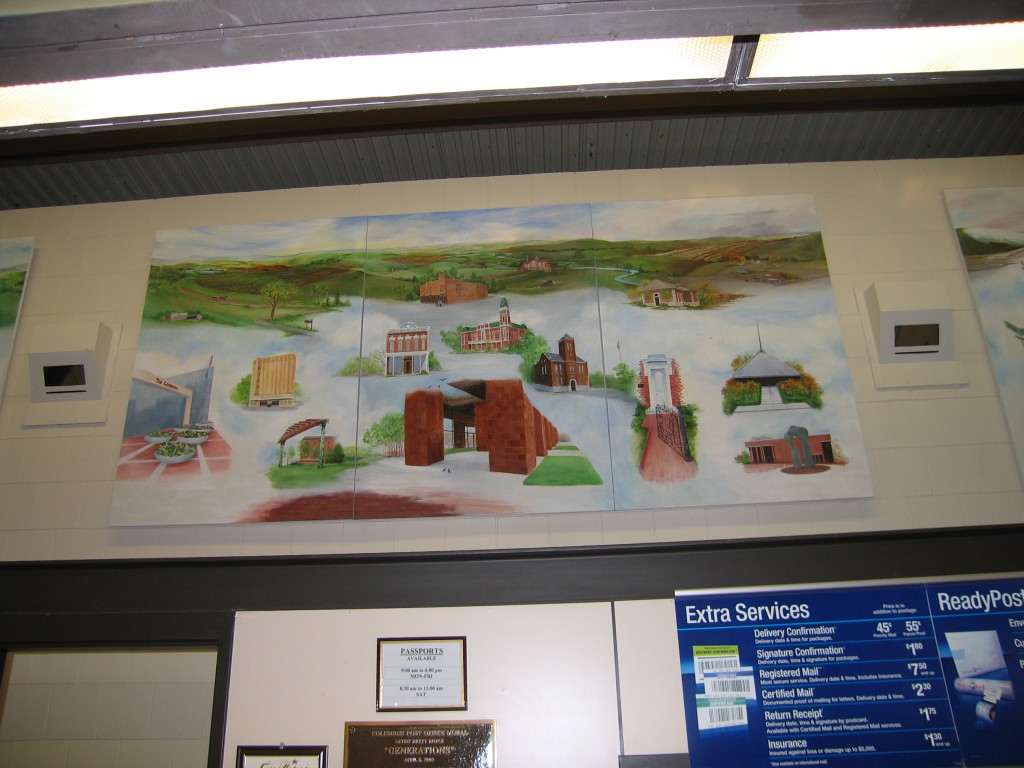 Panels 2, 3 and 4 of the Betty Boyle mural (photo by Ricky Berkey)
Panels 2, 3 and 4 of the Betty Boyle mural (photo by Ricky Berkey)
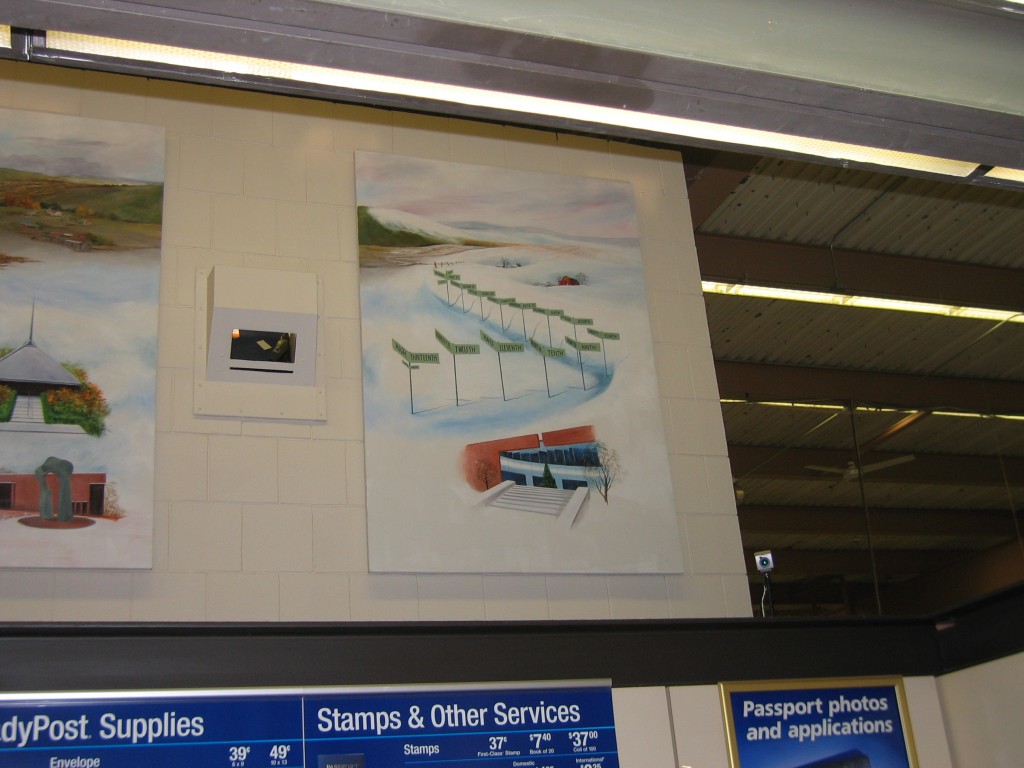 Panel 5 of the Betty Boyle mural (photo by Ricky Berkey)
Panel 5 of the Betty Boyle mural (photo by Ricky Berkey)
The Architects
 Eamonn Kevin Roche
Eamonn Kevin Roche
- Born: June 14, 1922 in Dublin, Ireland.
- National University of Ireland, Dublin (1945)
- Illinois Institute of Technology, Chicago (1949)
After graduation from college, Roche worked with Michael Scott in Ireland and Maxwell Fry in London from 1945-1948 before coming to the USA to study at IIT under Ludwig Mies van der Rohe. He joined Eero Saarinen’s firm in 1950 and within a few years became the Principal Design Associate to Eero Saarinen and worked closely on all Saarinen projects. When Eero Saarinen died in 1961, Roche completed a dozen projects already underway including the St Louis Gateway Arch, the CBS “Black Rock” building, the TWA Flight Terminal, Dulles International Airport and North Christian Church.
In 1966, Roche reorganized as Roche Dinkeloo & Associates along with partner John Dinkeloo and began many projects on their own. Major projects have included the Oakland Museum and the “Pyramids” buildings in Indianapolis. His works have included museums, corporate headquarters, performing arts centers and university buildings.
Other Roche projects in Columbus, Indiana:
- Cummins Midrange Engine Plant (1973)
- Addition to the downtown Irwin-Union Bank (1973)
- Cummins Corporate HQ (1983)
- Visitors Center Addition (1995)
- Addition to Cummins Plant One (1998)
- New Scoreboard at Otter Creek Golf Course (2010)
In addition to working with Eero Saarinen on the J. Irwin Miller Home in Columbus in the 50’s he also designed the largely unknown Miller residence in Florida in 1982. After John Dinkeloo died in 1981, Roche continued the practice with other partners but left the firm name the same to honor his long work with Dinkeloo.
Roche received the Pritzker Prize for architecture in 1982 and the AIA Gold Medal in 1993. The firm itself won the AIA Firm Award in 1974.
 John Gerard Dinkeloo
John Gerard Dinkeloo
- Born 1918 in Holland, Michigan
- Died 1981
- University of Michigan (1942)
John Dinkeloo was an engineer as well as an architect and an expert in construction technology. He started his career at the Chicago office of Skidmore Owings and Merrill (SOM) before joining Eero Saarinen in 1950.
He worked very closely with Kevin Roche to bring the Roche design ideas to life. In their partnership, Roche was the principal designer and Dinkeloo provided expertise in construction and technology. Their amazing partnership pioneered many new material technologies and construction techniques. Many of their buildings explored environmental techniques years ahead of our current “green” technology trends.
Links/References
Kevin Roche John Dinkeloo and Associates Official Website
City of Columbus: official City of Columbus website
Columbus Indiana Architectural Archives
Columbus Indiana Architecture Digital Archives: A small portion of the Columbus Indiana Architectural Archives available online from the IUPUI digital library
3D Models of Columbus Architecture Executed in Google SketchUp:
The Republic Newspaper – Columbus, Indiana newspaper
Bartholomew County Public Library
Historic Columbus Website – David Sechrest’s tribute to Columbus History
Historic Columbus Message Board – a companion interactive forum to the David Sechrest historical website
Bartholomew County Historical Society
 Click HERE for a Calendar of Upcoming Events in the Columbus Area.
Click HERE for a Calendar of Upcoming Events in the Columbus Area.
Click HERE for information about Tours of Columbus Architecture and Design including the Miller House.
 Ricky Berkey
Ricky Berkey
Email me: rickyberkey@gmail.com
